This week, De Montfort University Leicester (DMU)'s Class of 2020 graduated in the unique circumstances of the global pandemic. DMU archivist Katharine Short looks back at the evolution of the graduation ceremony since the foundation of the university in 1870. More photos can be seen on DMU Heritage's Facebook page.
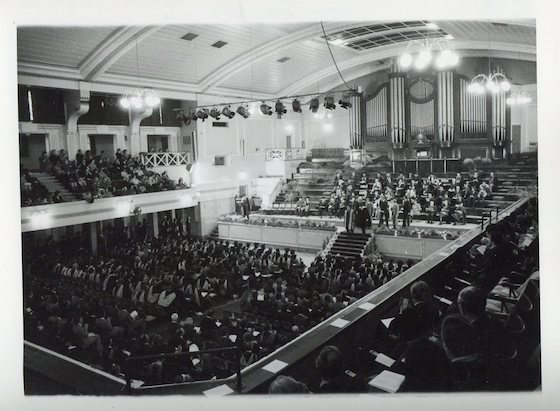
Graduations, 1970s style: De Montfort Hall was the venue for ceremonies for many years
The National Exhibition
The Leicester School of Art, founded in 1870, was not able to award its own qualifications. Schools of art had to follow the 'National Course of Instruction' syllabus, which comprised 23 stages from basic linear drawing through to the highest arts of figure painting. This was centrally organised by the Department of Science and Art based in South Kensington, who examined work sent in for an annual 'National Exhibition', and distributed awards and financial grants based on the quality of submissions.
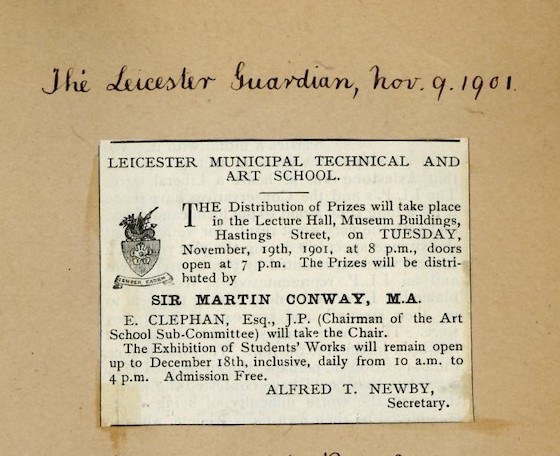
The prizes awarded to excellent students who achieved high marks in the National Exhibition included books, watercolour sets and mathematical instruments. Just a few years after it was founded, the School of Art usually placed in the top 5 schools in the country at the national exams.
As the institution grew and developed, it was still not able to award its own qualifications. Students continued to sit examinations which were validated or set by external bodies, such as the City and Guilds of London Institute or the University of London which allowed students to study elsewhere but still sit for university exams.
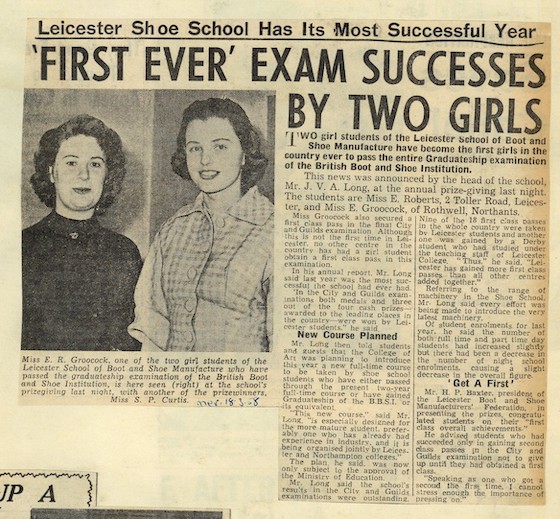
Prize-givings
The School of Art and its successors held annual prize-giving ceremonies to mark success in the various exams their students took. These usually included a guest speaker - the local newspapers would often print the entire text of their speech! There would also be a display of student work. As the institution grew larger after the Second World War, prize-giving ceremonies were organised by individual department rather than being a whole institution event.
The First Graduations
In 1969 the Colleges of Art and Technology became the City of Leicester Polytechnic. While the Polytechnic was still not able to confer its own degrees, it dropped so called 'lower-level' courses to focus on teaching undergraduate and postgraduate diploma and degree courses. All courses had to be validated by the Council for National Academic Awards (CNAA) which was the official degree-awarding body. A CNAA degree was considered equivalent to a university degree, the difference was a more flexible approach to teaching (polytechnics tended to have more part-time and mature students) and a focus on vocational subjects.
Becoming a polytechnic was a significant upgrade in status for the institution and it embraced the formal degree ceremony, based on the traditional university model. These ceremonies date back to medieval universities and were based on the pageantry of the church and trade guilds. During the ceremony the presiding officer, representing the university, confers the degree (and accompanying status) onto the student.
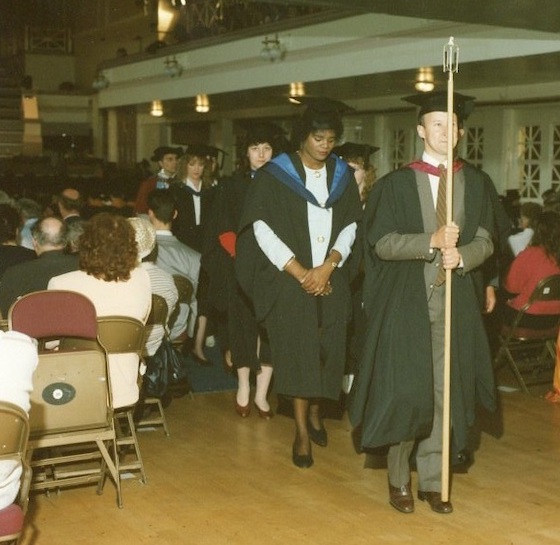
Processions, Gowns and Regalia
A key element of any graduation ceremony is the traditional pageantry, including processions, the wearing of gowns and the use of mace and staves. When Leicester Polytechnic became De Montfort University in 1992, able finally to award its own degrees, it adopted the full trappings of a university ceremony.
The procession enters the graduation venue in specific order, divided into groups by marshals carrying the university staves. The groups include academics, members of the Board of Governors and Academic Board, senior university staff and honoured civic guests, and the Vice Chancellor. At the end of the procession is the mace bearer followed by the Chancellor. As might be expected at an institution which teaches applied crafts, the mace and stave heads were designed and made in-house by members of staff.
Apart from the Chancellor, Vice-Chancellor, Pro-Chancellor and any recipients of Honorary Awards, the academics and guests in the procession wear the academic robes associated with the institution that they qualified from. The Chancellor wears a scarlet gown with gold trimmings and a soft black hat with gold cord, while the Vice-Chancellor wears a scarlet gown with gold trimmings and a black mortarboard with gold tassel.
The robes worn by graduands vary according to the degree they are being awarded and the Faculty they studied with, both in terms of the style of robe and hood and the colours used on the trimmings.
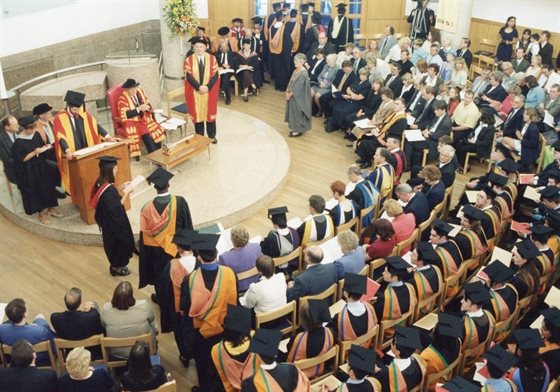
The venue in Milton Keynes, when DMU had a campus in the city, seen here in 1997
Venues
The first Leicester Polytechnic graduation was held in the large hall in the Hawthorn Building, a room which has subsequently been divided into smaller spaces. In 1970 the ceremony moved to De Montfort Hall, then in 2013 to the Curve Theatre until 2016, when The Venue building on DMU's campus was completed.
Into the Future
To close, here are some words from a degree ceremony speech given by Alderman Archibald Kimberlin in 1971:
I am here to congratulate those of you who are to receive degrees or diplomas on your success, and this I do warmly. They are useful things to hold ... [but what employers] will care about ... is whether it turns out to have been the end of your education or only the end of the beginning.
Kimberlin goes on to tell students that it will be an achievement if:
halfway through your careers, people continue to recognise in you a continued capacity for learning, an original and enquiring mind, [and] a breadth of interest and of sympathy.
Posted on Saturday 22 August 2020